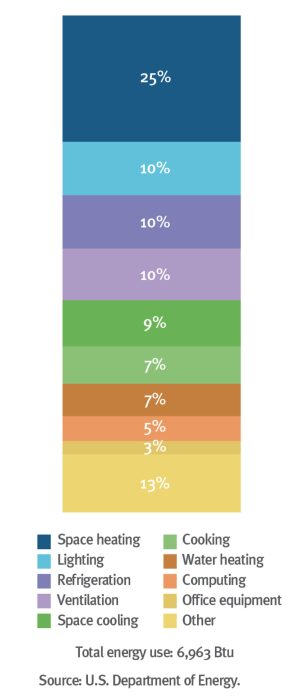Why is sustainability such an important issue?
For decades now, scientists have warned that the production of greenhouse gases is trapping heat in the atmosphere, raising average temperatures in ways that are disrupting the natural world and present a real risk to the future of humanity.
In response to their warnings, over 190 countries finally agreed in 2015 to limit the production of those gases in order to contain the rise of mean global temperature to no more than 2°C (3.6°F) and preferably closer to 1.5°C (2.7°F) above pre-industrial levels. In that agreement, the Paris Climate Accords, most of the world’s nations pledged to work toward the decarbonization of their economies—basically, to phase out the use of carbon-producing fossil fuels and use renewable energy instead.
This fall, a follow-up climate summit was held in Glasgow. In his summary following the conference, Achim Steiner of the United Nations Development Program concluded that the 1.5°C goal is still alive, but barely, and “the world is still far short of where it needs to be to stem the impacts of climate change.”
What if we don’t make that number? What difference could a couple of degrees make?
The most common scenario is that storms and heat waves would continue to worsen. The Intergovermental Panel on Climate Change has estimated that 2°C of warming would destroy about 13 percent of global land ecosystems. Eventually, something even more dramatic could happen, such as the total meltdown of the West Antarctica Ice Sheet, an event that would raise sea levels by 11 feet (3.3 m) and flood many of the world’s cities.
“Think of it as a game of Jenga and the planet’s climate system as the tower,” wrote analysts at the World Economic Forum, the pro-business organization that sponsors the annual Davos conference. “For generations, we have been slowly removing blocks. But at some point, we will remove a pivotal block . . . that will cause all or part of the global climate system to fall into a planetary emergency.”
But I don’t work for an automaker or an airline; I’m in real estate. What does my business have to do with climate change?
A lot more than you might think. Buildings play a big role in global warming—bigger than any other sector. Arup, the global engineering consultancy, estimates that 39 percent of global emissions are tied up in building operations and construction, compared with 32 percent for industry and 23 percent for transportation.
There are so many competing priorities for time and resources in my business? Why should I focus on decarbonization?
Whatever your personal doubts about climate change, it is worth keeping in mind that some of the biggest investors in the world are convinced.
Larry Fink, chairman and chief executive officer of BlackRock, the world’s largest asset manager (with $9.456 trillion in assets under management), has stated very clearly that “climate risk is investment risk,” and warned CEOs that the industry is at the beginning of a long but rapidly accelerating transition toward a sustainable economy “that will unfold over many years and reshape asset prices of every type.”
The enthusiasm of Fink and others on Wall Street makes sustainability an opportunity as well as a risk: many institutional investors are now looking for green assets, and some lenders offer a discount on their lending rate for green-related projects. This is not altruism: investors say that greener buildings are more energy-efficient and have less risk of becoming stranded assets down the line.
How do buildings use energy?
The U.S Department of Energy estimates that energy use in buildings currently breaks down this way:
I don’t think my tenants would want to give up any of those items. Is it even possible to cut our emissions by a significant amount?
It is not just possible; it is already happening. Members of the ULI Greenprint Center for Building Performance, a consortium of the world’s leading real estate owners, investors, and strategic partners, have reduced their 11,991 properties’ use of energy, carbon, water, and waste by 3 percent a year for 10 years in a row, putting them on track to reduce their collective greenhouse gas emissions by 50 percent by 2030 and reach net zero carbon by 2050. The fact that they manage $1.3 trillion in assets and 2.92 billion square feet (214 million sq m) of space in 30 countries suggests that their success is not a fluke.
What can I do to begin decarbonizing my real estate portfolio?
“There is a lot that can be done to get you on that journey, which we put in the low- and no-cost measures bucket—things like lighting upgrades, HVAC improvements, even putting solar panels on roofs,” says Abigail Dean, head of sustainability for Nuveen. “Whilst you might not be able to get a building to net zero carbon without there being a clear demand from occupiers, you can get a building to be very energy efficient without needing to see that uplift in demand from occupiers.”
For Simone Pozzato, fund manager for the environmental, social, and governance (ESG) award–winning Hines European Core Fund, tenant relationships are the key. In an email, he suggested following a three-step program:
- Establish a good partnership with your tenants. Enter into a trusting relationship where they will share their energy-consumption data and behaviors with you.
- Once consensus is reached, establish smart metering and monitor patterns and data flows.
- Take action. Suggest ways to:
- reduce consumption: activity hours, inefficient processes, and additional stress on the network.
- implement capex where cost/benefit will be more effective: monitoring and evaluation systems, insulation, energy production (solar panels).
- propose pre-agreed/negotiated packages with renewable energy providers.
The key is step one: establishing a trusting relationship. Without this, nothing can follow.
BENNETT VOYLES is a Berlin-based business writer.
Related Article: Growing Pains for Green Investing














